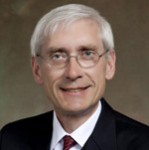Gov. Evers, Office of Sustainability and Clean Energy Release State’s First-Ever Clean Energy Plan
Evers Administration plan outlines strategies to lower energy bills for families, reduce reliance on out-of-state energy sources, invest in job and apprenticeship training, create more than 40,000 jobs by 2030
MADISON — Gov. Tony Evers today, together with the Office of Sustainability and Clean Energy, released the state’s Clean Energy Plan, the first-ever plan in the state’s history as the governor directed in Executive Order #38. The Clean Energy Plan identifies dozens of paths and strategies aiming to lower energy bills and prices at the pump for Wisconsin families, promote energy independence by reducing reliance on out-of-state energy sources, create an estimated more than 40,000 jobs by 2030, and invest in job training and apprenticeship programs in innovative industries and technologies.
Wisconsinites continue to be concerned by rising costs in grocery store aisles and at gas pumps while industries face challenges getting resources and supplies. Oil and gas prices have been subject to major disruptions and volatility due to the Russian invasion of Ukraine, creating uncertainty in markets at home, including gas prices in Wisconsin which recently exceeded $4 per gallon. National inflation has also recently reached the highest level in decades. At the same time, the plan comes as there are historic opportunities presented by an influx of federal dollars to invest in once-in-a-generation efforts to speed up production of cheaper, cleaner energy, replace water infrastructure to ensure access to safe, clean drinking water, reduce the impacts of extreme weather, help families and businesses save on energy costs through energy efficiency, and invest in innovative jobs, job training, and apprenticeship programs. A 2019 study conducted by the Center on Wisconsin Strategy estimated that, each year, Wisconsin sends more than $14 billon out of state due to the state’s dependence on out-of-state energy sources.
“Wisconsinites should have the opportunity to make their own decisions about their energy use. Every year, we’re losing more than $14 billion we’re sending out of state, and that’s money we could be using to invest in clean, made-in-Wisconsin energy to help lower energy bills while also creating good-paying job opportunities and apprenticeship training in innovative technologies and industries,” said Gov. Evers. “By expanding and speeding up production of cheaper, cleaner energy like wind and solar here in Wisconsin, we can keep our money here at home rather than relying on unpredictable markets often disrupted by foreign leaders and conflicts.”
The plan, which aims to change the adverse trajectory of the effects of a changing climate, builds on the work of the Evers Administration over the last three years, including the Governor’s Task Force on Climate Change, but it was also designed to be flexible to adapt to future technology innovation and market changes. The plan considers and incorporates thoughts, plans, and suggestions of people and entities throughout Wisconsin, including utilities, private industry, frontline communities, Tribal Nations, government partners, and academic experts, among others, to provide a framework to ensure Wisconsin can transition toward cheaper, cleaner energy.
Gov. Evers previously signed Executive Order #38, creating the Office of Sustainability and Clean Energy, charged with developing the Wisconsin Clean Energy Plan to promote the development and use of clean and renewable energy across the state, advance innovative sustainability solutions that improve the state’s economy and environment, and diversify the resources used to meet the state’s energy needs. The order also established the state’s goal to reach 100 percent carbon-free electricity by 2050. Additionally, Gov. Evers also previously joined the U.S. Climate Alliance, a bipartisan group of governors who are committed to implementing the 2015 Paris Climate Agreement at the state level in an effort to combat climate change. Executive Order #38 also charged the Office of Sustainability and Clean Energy with ensuring the state is fulfilling the carbon reduction goals of the Paris Agreement. The objectives identified in the Clean Energy Plan include putting Wisconsin on a path to achieve 100 percent carbon-free electricity by 2050 and ensuring that the state of Wisconsin is contributing to the carbon reduction goals of the Paris Agreement.
“The Office of Sustainability and Clean Energy is pleased to roll out the state’s first Clean Energy Plan,” said Maria Redmond, director of the Office of Sustainability and Clean Energy. “Over the past two years the OSCE team worked to create a collaborative path forward to address emissions in our state, and I’m looking forward to implementation of this plan and to continuing to work with partners across the state to support sustainable local economies, environmental justice, and direct actions to address climate change. The long-term impacts of the Clean Energy Plan and our collaborative efforts moving forward are vital to building a sustainable clean energy future.”
In addition to outlining efforts to meet the state’s carbon-free electricity goal and goals in the Paris Agreement, the plan also includes objectives toward reducing the disproportionate impacts of energy generation and use on low-income communities and communities of color, maximizing the creation of and equitable opportunities for clean energy jobs, economic development, and retention of energy investment dollars in Wisconsin, improving the reliability and affordability of the energy system, strengthening the clean energy workforce through training, reskilling, and education, and protecting human and environmental health, among other key strategies. The Clean Energy Plan is available here and includes four major pathways to a clean, reliable, and affordable energy future:
- Accelerate Clean Energy Technology Deployment by expanding Focus on Energy incentives, updating generation emission goals, leveraging existing state and federal programs and increasing funding options for projects, bolstering renewable infrastructure with projects like community solar development, and fostering advanced technology development by supporting businesses working to develop these technologies, among many other recommendations.
- Maximize Energy Efficiency by setting energy efficiency resource standards, increasing Focus on Energy program funding, increasing voluntary utility investments in energy efficiency, reducing agriculture energy use, promoting creative financing options and additional energy efficiency measures for low-income Wisconsinites, empowering schools to fund or implement energy efficiency programs, and supporting commercial and industrial energy efficiency, among many other recommendations.
- Modernize Buildings and Industry by updating commercial building codes, utilizing local building products and protecting Wisconsin forests, developing low-carbon building materials procurement policies, scaling up renewable heating and cooling in the industrial and building sectors, and deploying rapid building electrification, among many other recommendations.
- Innovate Transportation by supporting the transition to electric vehicles, bolstering electric vehicle charging infrastructure, leveraging available federal funding to build out this infrastructure, supporting municipalities in expanding multimodal options for communities, and connecting communities in ways that support alternative transportation, among many other recommendations.
In addition to the four pathways identified above, the Clean Energy Plan also includes several workforce development recommendations to ensure Wisconsin has a clean energy workforce to meet these needs, including establishing clean energy apprenticeship tracks, working with technical colleges to develop pathways into the industry, supporting reentry skills training programs for incarcerated individuals, and creating a Clean Energy Workforce Advisory Council to bring leaders together across industries. The Office of Sustainability and Clean Energy estimates with full implementation of this plan, the state could see more than 40,000 new jobs by 2030.
An online version of this release is available here.
NOTE: This press release was submitted to Urban Milwaukee and was not written by an Urban Milwaukee writer. While it is believed to be reliable, Urban Milwaukee does not guarantee its accuracy or completeness.
Mentioned in This Press Release
Recent Press Releases by Gov. Tony Evers
Gov. Evers Approves New Rule Aimed at Keeping Kids in Foster Care With Family and Loved Ones
Dec 18th, 2025 by Gov. Tony EversRevised rule creates streamlined licensing pathway for relative and like-kin caregivers, keeping more kids with adults who know and love them





















